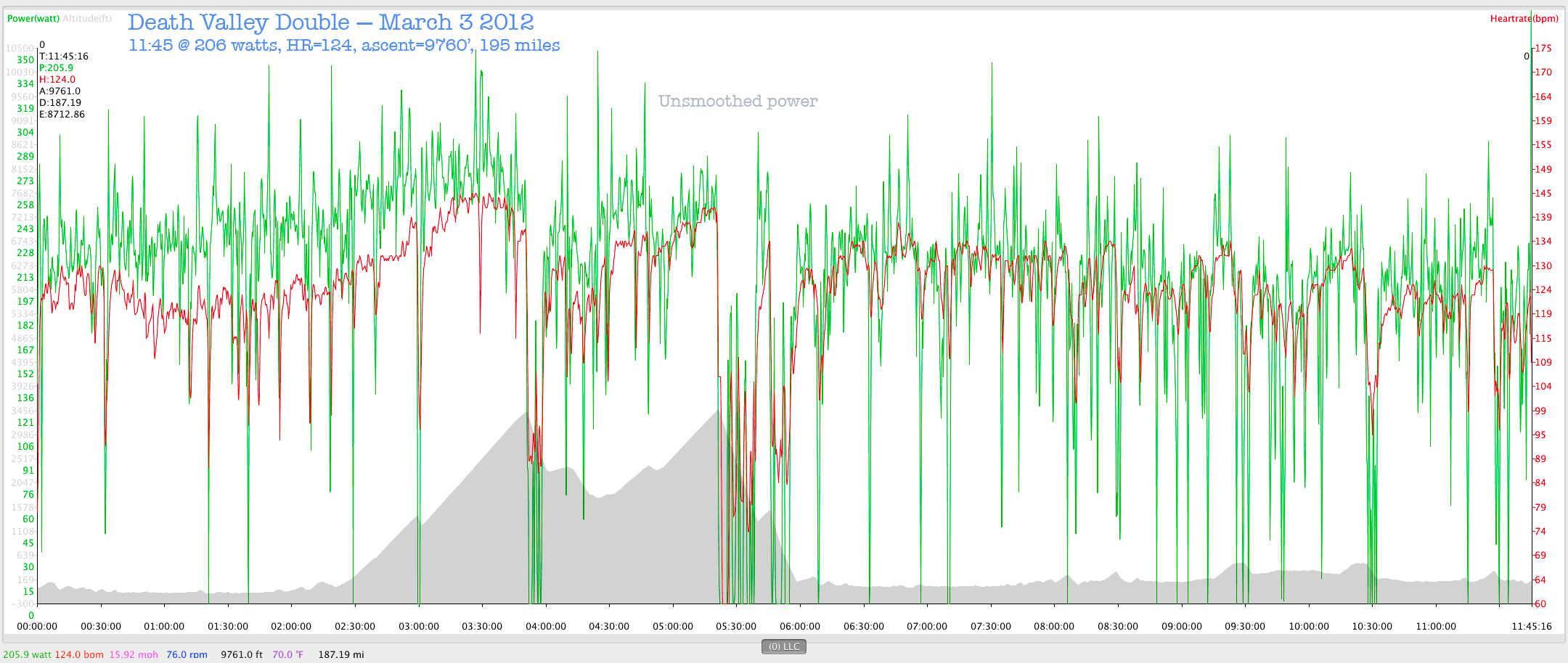Analyzing Power Output During the Death Valley Double Century
See my notes on how I rode the Death Valley Double.
The power meter data is really useful in analyzing performance
Let’s analyze how I did on the 195 mile ride. Note that wattage and heart rate are averages only when power is active (when pedaling). Averages do not include time coasting (not pedaling), but do include “soft pedaling” downhill.
The clock time was just shy of 13 hours from start to finish. The graph below shows the time the bike was actually moving was 11:45, which means 75 minutes were spent for all my self-supported stops. This was a solo ride, no drafting at any time, so all power figures are purely my own effort into the prevailing conditions.
I key recording to speed and cadence, so if the bike stops, recording stops. One can key it to heart rate, but then if the heart rate stops then recording stops even if there is power and cadence (and during DVD the heart rate strap did come apart for a few minutes).
Mileage shown is low by 8 miles due to the speed sensor not picking up until mile 8, one more stop I had to make.
[0 - 3:48, first 54 miles]: 238 watts @ 126 bpm [0 - 8:38, first 142 miles]: 213 watts @ 125 bpm
[9:45 - 11:45, last 58 miles]: 187 watts @ 122 bpm
Click for a larger graph.

Analysis
Heart rate largely tracks power output and shows little sign of dehydration, no surprise there since I was very well hydrated at hour 8-9 (nearly clear urine), and only the last 3 hours did I experience very modest fluid loss. I drank 3+ gallons for the day. And late in the day, I learned how to relieve myself while coasting. Quite useful, so long as there are no spectators!
Power was very strong for the first ~4 hours, and still excellent for the first 7 hours. Indeed, I felt *great* to about the 110 mile mark, and only two riders had caught up to me, and neither was doing the double century (I asked/checked). And I was passing rider after rider (mostly shorter distance riders who had turned around). It was a nice psychological boost.
But somewhere around the 132 mile mark, I noted a distinct change in how I felt; I lost my sense of whether I needed to eat or drink (which had been fine until that point), and I also lost my mental focus in terms of watching the clock to see when I should do so. So I was then flying blind. It was about this time that my power output began to decline, both in peak power as well as sustained power. I suspect that I began to take in too few calories around that point, as I simply lost all desire to eat anything.
At around the 140 mile mark (about where the 2nd graph begins), I began questioning my sanity— with 60 miles to go the fun was pretty much gone. It became a mental game of avoiding negative self-talk. I succeeded by force of will in beating back such thoughts, but the ride had become a slog and was no longer enjoyable. Grin and bear it.
The last 50 miles I put in a respectable effort in terms of power, but compare the power output (green line) to the faint gray 230 watt line as seen to the left; the reduction in average power as the ride progresses in the 8-12 hour range is plain to see.
Conclusions
It seems that I did a very good job until the ~130 mile mark— I’m very satisfied with my performance to that point. The issue is how to extend that performance for 200 miles.
With 60 miles to go, something “happened”. The simple explanation of “fatigue” is not satisfying, because I felt like nothing was wrong with my legs. It was more of a general lack of energy. I am certain that I was still well hydrated, but I had lost interest in eating anything, so I suspect that the energy loss might have been glycogen related. But it might also have been a threshold at which physiological processes break down in mysterious ways— I have very little past experience in the 130+ mile range. I had no means to take in calories via fluid (messy powders weren’t practical). Perhaps the availability of pre-mixed Perpetuem might have helped if it had been available.
Therefore, my focus for the Solvang Spring Double necessarily involves careful monitoring of my caloric intake beyond the 100 mile mark. As an official Solvang Spring Double participant able to obtain pre-mixed liquid calories, perhaps my body will react differently. Or perhaps there will still be a “wall” at around the 130 mile mark. Ultimately I would like to be able to ride the entire 200 miles with less than a 5% loss of power for the last 50 miles.








